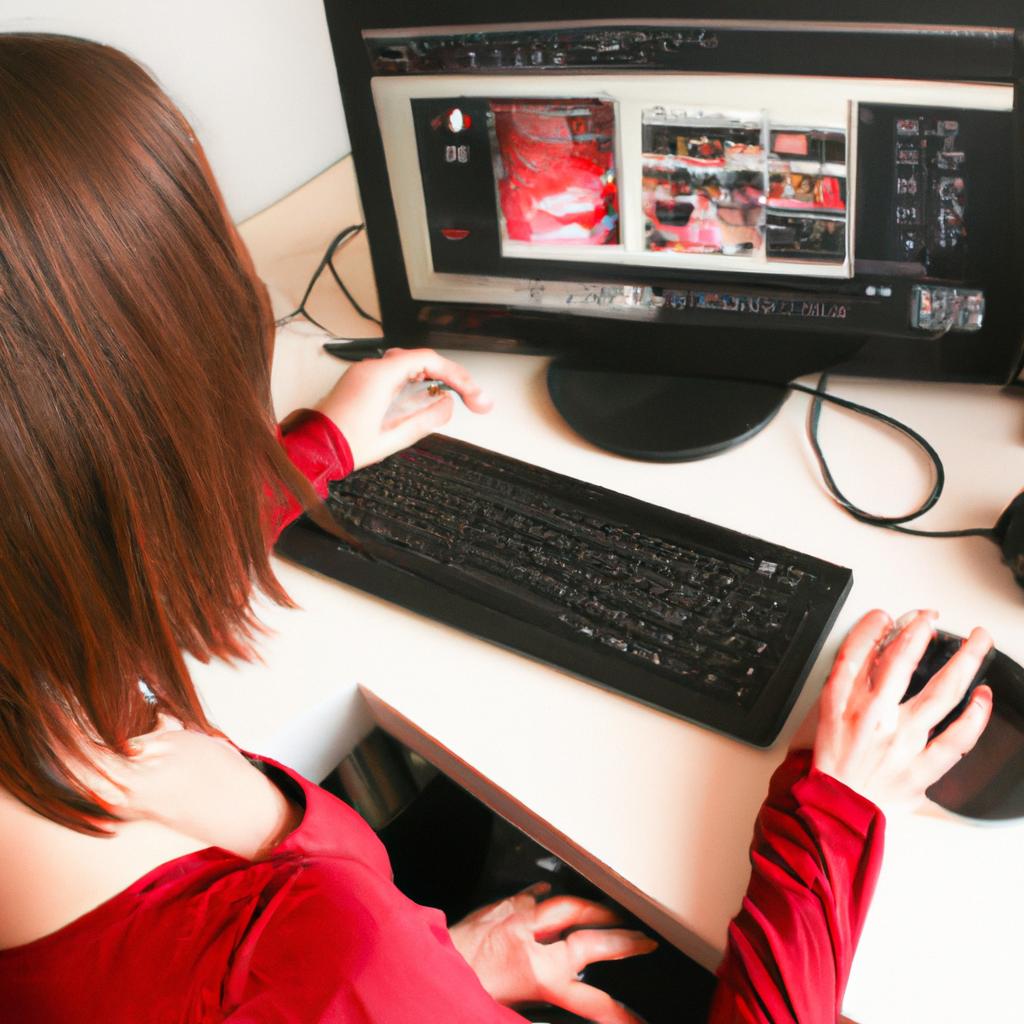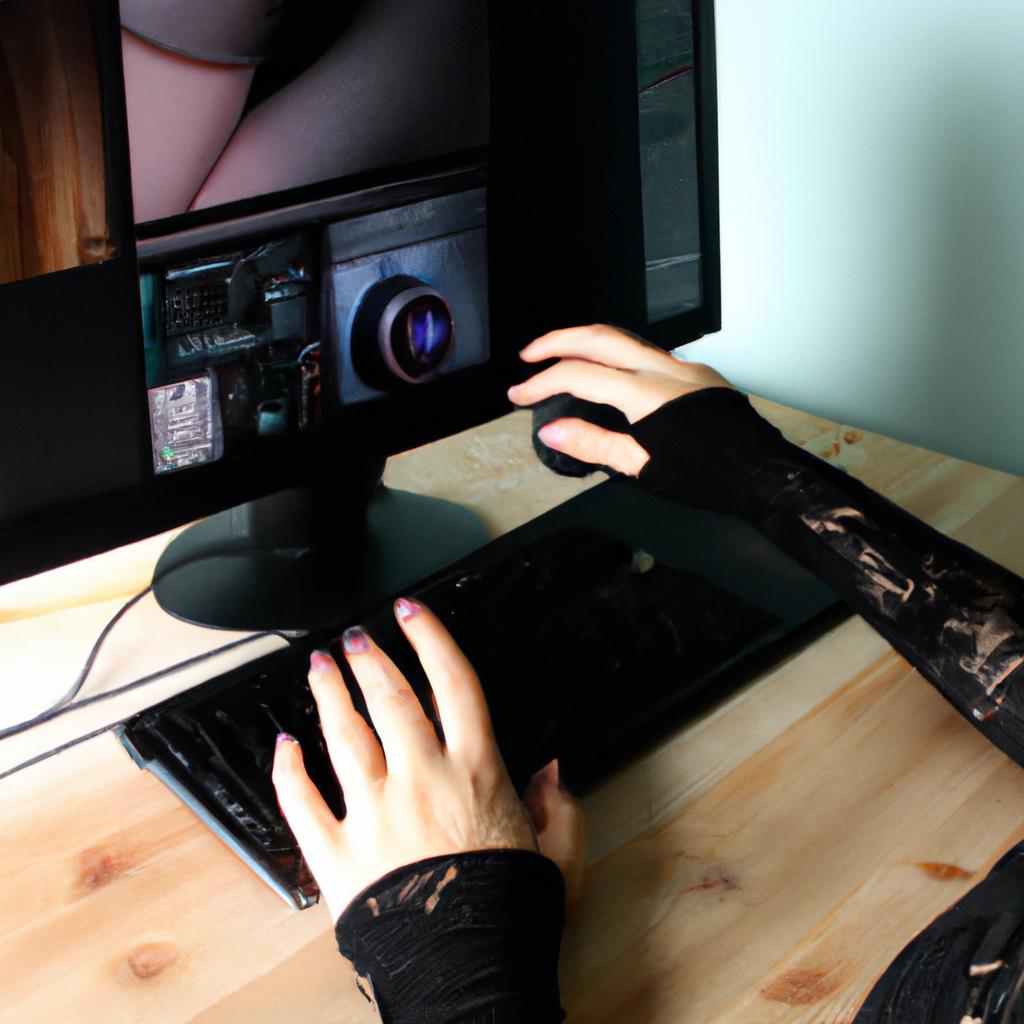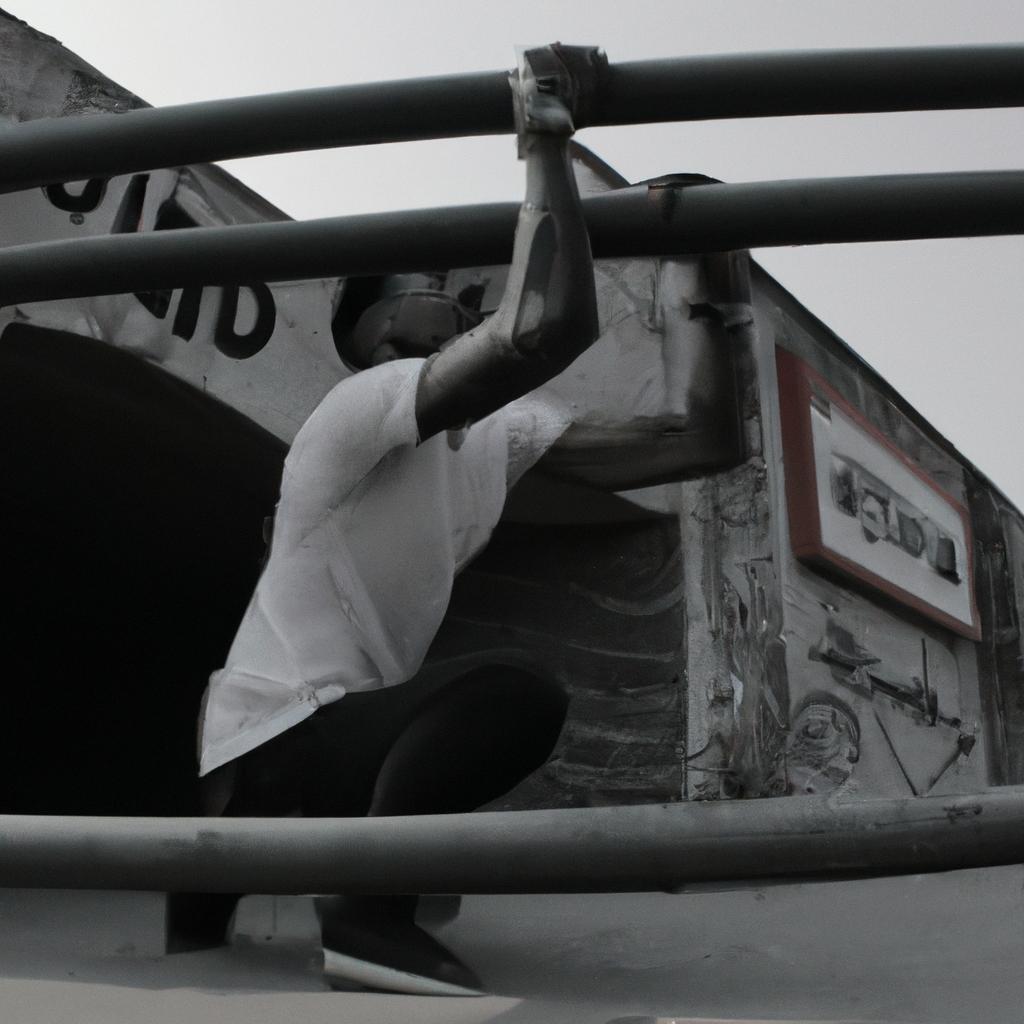Boudoir photography, a form of intimate and sensual portraiture, has gained significant popularity in recent years. This genre of photography focuses on capturing the essence and beauty of individuals in a private setting. However, what truly sets boudoir photography apart is its diverse range of editing styles that can be applied to enhance mood and evoke emotions. In this article, we delve into the world of boudoir photography editing styles, specifically focusing on unveiling the enigmatic “Moody” style.
Consider for instance a hypothetical case where a photographer aims to create an alluring and mysterious atmosphere through their boudoir images. The Moody style allows them to accomplish precisely that by employing various techniques such as dramatic lighting, deep shadows, and desaturated tones. By manipulating these elements during post-processing, the photographer can transform an ordinary photograph into one that exudes sensuality and intrigue. Such an example not only demonstrates the potential impact of editing choices but also highlights how the Moody style offers photographers the creative freedom to craft unique visual narratives within the realm of boudoir photography.
Understanding Boudoir Photography
Boudoir photography is a unique genre that captures intimate and sensual moments, typically featuring individuals in various states of undress. It aims to celebrate the beauty, confidence, and empowerment of its subjects while capturing their vulnerability with artistic finesse. To comprehend the essence of boudoir photography fully, it is essential to explore its origins, techniques employed, and the impact it has on both photographers and clients.
One example showcasing the power of boudoir photography involves a woman named Sarah who sought out this art form as a means of self-expression and personal growth. Through her boudoir session, she was able to embrace her body image insecurities and tap into newfound levels of self-confidence. This transformational experience highlights how boudoir photography can serve as a catalyst for positive change by empowering individuals to embrace their true selves.
To evoke an emotional response in audiences, consider these key aspects:
- Emotionally Liberating: Boudoir sessions provide an opportunity for individuals to break free from societal norms and expectations surrounding body image.
- Celebration of Individuality: Each photoshoot focuses on highlighting the uniqueness and individual beauty possessed by every subject.
- Safe Space: Professional photographers create a safe environment where clients feel comfortable expressing their sensuality without judgment or fear.
- Confidence Boosting: The resulting images often empower individuals by reminding them of their inherent worthiness and desirability.
The following table further highlights some common editing styles used in boudoir photography:
| Editing Style | Description | Emotion Elicited |
|---|---|---|
| Moody | Enhances shadows and adds depth to create an intense atmosphere | Mystery and allure |
| Soft & Dreamy | Utilizes soft lighting and pastel tones for a romantic ambiance | Innocence and tenderness |
| Vibrant & Bold | Amplifies colors for a bold, eye-catching effect | Confidence and empowerment |
| Black & White | Strips away color to emphasize shape, form, and texture | Timelessness and elegance |
Understanding the art of boudoir photography goes beyond technicalities; it requires a deep appreciation for capturing intimacy in its purest form. By employing various editing styles and techniques, photographers can evoke specific emotions while showcasing their subjects’ vulnerability. This exploration into the world of boudoir photography sets the stage for our subsequent discussion on “The Art of Capturing Intimacy.”
The Art of Capturing Intimacy
Unveiling Moody: Exploring Boudoir Photography Editing Styles
Understanding the intricacies of boudoir photography is essential for capturing intimate moments effectively. In this section, we will delve into the various editing styles commonly used in boudoir photography to enhance mood and highlight the sensual aspects of the images.
To illustrate these editing styles, let’s consider a hypothetical scenario where a photographer wants to convey elegance and sensuality through their boudoir photographs. By employing different editing techniques, they can create distinct moods that evoke specific emotions from viewers. For instance, using soft lighting and pastel tones during post-processing can produce an ethereal atmosphere, evoking feelings of delicacy and romance.
In exploring the range of editing styles available in boudoir photography, several key elements come into play:
- Color grading: The choice of colors can significantly impact the overall mood of a photograph. Warm hues like gold or red may exude passion and desire, while cooler tones like blue or purple might invoke tranquility or mystery.
- Contrast adjustment: Manipulating contrast levels allows photographers to emphasize certain features within an image. A higher contrast setting accentuates shadows and highlights, adding depth and drama to the composition.
- Skin retouching: While maintaining authenticity is crucial in boudoir photography, subtle skin retouching techniques can help enhance natural beauty without distorting reality.
- Vignetting: The use of vignettes draws attention towards the subject by darkening the edges of an image slightly. This technique creates a sense of intimacy and focuses on the central figure.
By combining these elements with skillful editing techniques, photographers can achieve stunning results that resonate emotionally with viewers.
Transitioning seamlessly into our subsequent section about “Unveiling Moody: A Closer Look,” let us now examine specific examples where moody edits have been successfully employed in boudoir photography. Through detailed analysis and case studies, we will uncover the methods used to create these captivating and evocative images.
Unveiling Moody: A Closer Look
Transitioning from the exploration of boudoir photography, it is crucial to delve deeper into the various editing styles that contribute to creating moody and captivating images. By employing specific techniques during post-processing, photographers can enhance the mood, atmosphere, and overall aesthetic appeal of their boudoir photographs. To illustrate this concept, let us consider a hypothetical case study featuring a boudoir photographer named Sarah.
Sarah, an experienced boudoir photographer with a keen eye for detail, recently captured a series of intimate portraits in her studio. In order to convey a sense of raw emotion and intensity through her imagery, she decided to experiment with different editing styles. Through careful manipulation of lighting, color grading, and contrast adjustments during post-processing, Sarah aimed to evoke feelings of sensuality and mystery in her final images.
To achieve these desired effects within her work, Sarah employed several key editing techniques:
- Careful selection of hues and tones: By selecting warm or cool color palettes depending on the intended mood, Sarah was able to create distinct atmospheres within each photograph.
- Strategic use of shadows: Utilizing shadow play effectively added depth and dimension to the images while also accentuating certain features or body curves.
- Controlled highlights: Balancing brightness levels allowed Sarah to draw attention to specific areas or highlight details without overpowering the overall composition.
- Manipulation of texture: Enhancing or softening textures such as skin or fabric contributed significantly to conveying emotions subtly yet powerfully across her portfolio.
Emphasizing these aspects during post-processing enabled Sarah’s boudoir photographs to exude an air of intimacy and allure. The table below provides further insight into how different editing techniques can shape the mood conveyed within an image:
| Editing Technique | Mood Conveyed |
|---|---|
| Warm Color Palette | Passionate |
| Cool Color Palette | Mysterious |
| Dramatic Shadows | Seductive |
| Soft Highlights | Subtle |
By strategically employing these editing techniques, photographers can effectively evoke a wide range of emotions and create visually captivating boudoir photographs.
Transitioning into the subsequent section about “Choosing the Right Editing Techniques,” it is essential to consider not only the desired mood but also how different editing styles align with individual artistic preferences.
Choosing the Right Editing Techniques
In the previous section, we delved into the concept of unveiling moody aesthetics in boudoir photography. Now, let us explore the various editing styles that can be employed to bring out this desired mood and ambiance. By carefully selecting and applying specific editing techniques, photographers can create captivating images that evoke a sense of intimacy and allure.
To illustrate the impact of different editing styles, let’s consider an example. Imagine a boudoir photograph taken in natural light with soft shadows gently caressing the subject’s curves. This image already possesses a certain level of sensuality, but by employing specific editing techniques, such as adjusting color tones and enhancing contrast, it can be transformed further into a more dramatic and mysterious composition.
When it comes to creating moody atmospheres through post-processing, there are several key elements to consider:
- Color palette: Utilize deep and rich colors like burgundy or dark blues to enhance the overall moodiness.
- Contrast: Increase contrast between highlights and shadows to add depth and dimension to the image.
- Texture enhancement: Emphasize texture details through careful sharpening or selective adjustments.
- Vignetting: Employ vignettes to draw focus towards the center of the frame, intensifying the intimate atmosphere.
By utilizing these techniques strategically, photographers have a wide range of possibilities for achieving their desired aesthetic. To better understand how different editing styles influence the final outcome, refer to Table 1 below which showcases various approaches commonly used in boudoir photography:
| Editing Style | Characteristics | Emotional Response |
|---|---|---|
| Filmic | Mimics classic film grain | Nostalgia |
| Matte | Softens highlights and reduces saturation | Elegance |
| High Contrast | Dramatic tonal range | Intensity |
| Desaturated | Reduces vibrancy and saturation | Subtlety |
Table 1: Common Editing Styles in Boudoir Photography
In summary, by manipulating color tones, contrast, texture, and vignettes, photographers can create captivating boudoir images with a moody ambiance. The choice of editing style depends on the desired emotional response and aesthetic appeal sought for each photograph. In the subsequent section, we will explore another crucial aspect in unveiling moody aesthetics – the interplay between light and shadow.
Unveiling Light and Shadow through Composition
Exploring Light and Shadow
Unveiling Moody: Exploring Boudoir Photography Editing Styles
Section H2: Choosing the Right Editing Techniques (Continued)
In our previous discussion, we examined several editing techniques that can be employed to enhance the overall mood of boudoir photography. Now, let us delve deeper into the realm of light and shadow manipulation, a crucial aspect in creating captivating and alluring images.
To illustrate this concept, consider a hypothetical scenario where a photographer is working on a series of boudoir photographs that aim to evoke a sense of intimacy and sensuality. By skillfully adjusting the lighting during both the photoshoot and post-processing stage, they are able to accentuate certain features while leaving others partially obscured by shadows. This intentional play with light and shadow adds depth and mystery to the final images, heightening their emotional impact.
To further comprehend the significance of light and shadow manipulation in boudoir photography, here are some key points:
- Shadows have an innate ability to create visual interest and add drama to an image.
- The strategic use of lighting can emphasize or de-emphasize specific areas within a photograph.
- Contrasting light and shadow can elicit feelings of seduction, allure, or vulnerability.
- Thoughtfully incorporating shadows can help establish a narrative within each frame.
Table 1 provides a comprehensive overview of various lighting scenarios commonly used in boudoir photography:
| Lighting Scenario | Description | Emotional Response |
|---|---|---|
| Soft Light | Gentle diffusion resulting in subtle highlights | Calmness, tenderness |
| Hard Light | Direct illumination producing distinct shadows | Intensity, boldness |
| Rembrandt Lighting | Triangle-shaped light falling across one side of face | Elegance, sophistication |
| Backlighting | Illumination from behind subject | Ethereal glow, mystique |
By strategically employing these lighting techniques, photographers can effectively enhance the emotion and atmosphere of their boudoir photographs. The interplay between light and shadow contributes to a captivating visual narrative that engages viewers on multiple levels.
Transitioning into our next section, we will explore how additional editing adjustments can further enhance the emotional impact of boudoir photography, leading to even more compelling and evocative results. We will delve into various post-processing techniques that allow for precise control over color grading, contrast enhancement, and other elements that contribute to mood manipulation.
Enhancing the Emotion
Exploring Light and Shadow has laid the foundation for understanding how different lighting techniques can shape the mood of boudoir photography. Now, let us delve further into another crucial aspect of editing styles that contribute to unveiling the desired moody atmosphere in these captivating images.
Imagine a scenario where a photographer captures an intimate boudoir photograph with soft backlighting, creating a sensual ambiance. However, during the post-processing stage, the photographer decides to enhance certain elements by adjusting the contrast and tonal range. By darkening shadows and boosting highlights, they emphasize the depth of emotions evoked by their subject’s pose and expression. This deliberate manipulation of light and shadow enables them to create a heightened sense of drama and mystery within the image.
To fully appreciate the various editing styles utilized in boudoir photography, it is essential to consider key aesthetic elements that contribute to achieving a moody atmosphere. These include:
- Color grading: The choice of color palette plays a significant role in setting the mood. While warmer tones evoke sensuality and intimacy, cooler hues tend to convey melancholy or introspection.
- Texture enhancement: Adding texture overlays or selectively sharpening specific areas can further accentuate details such as lace lingerie or intricate patterns on bedsheets, intensifying visual interest.
- Vignetting effects: Gradually darkening edges around the subject directs focus towards central elements, reinforcing intimacy while adding an element of intrigue.
- Film-inspired presets: Applying film-like filters emulates traditional analog aesthetics associated with vintage romance, lending photographs an emotive quality reminiscent of classic cinematic storytelling.
Consider Table 1 below which illustrates how each editing style impacts our emotional response:
| Editing Style | Emotional Response |
|---|---|
| Warm Tones | Sensuality |
| Cool Hues | Melancholy |
| Texture Enhancement | Visual Interest |
| Vignetting Effects | Intimacy & Intrigue |
In conclusion, the art of boudoir photography editing extends beyond capturing light and shadow. By skillfully applying various techniques such as color grading, texture enhancement, vignetting effects, and film-inspired presets, photographers can evoke specific emotions in their audience. As we move forward to explore enhancing the emotion within these captivating images, we will further unravel the secrets behind creating truly mesmerizing moody masterpieces.
 LW Larsen Photo
LW Larsen Photo



